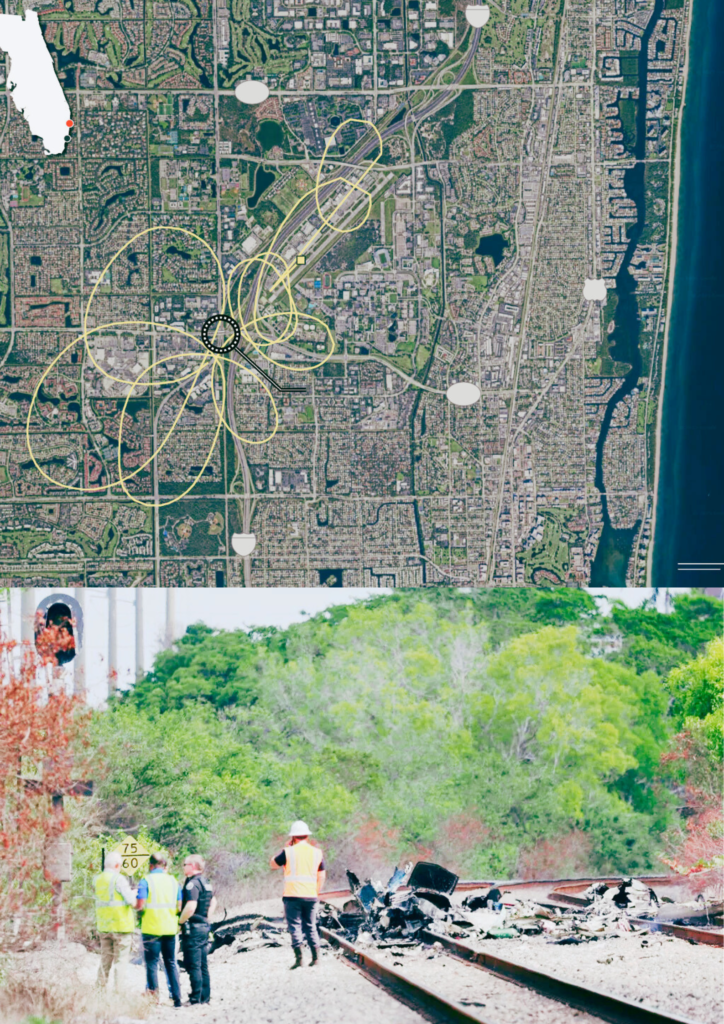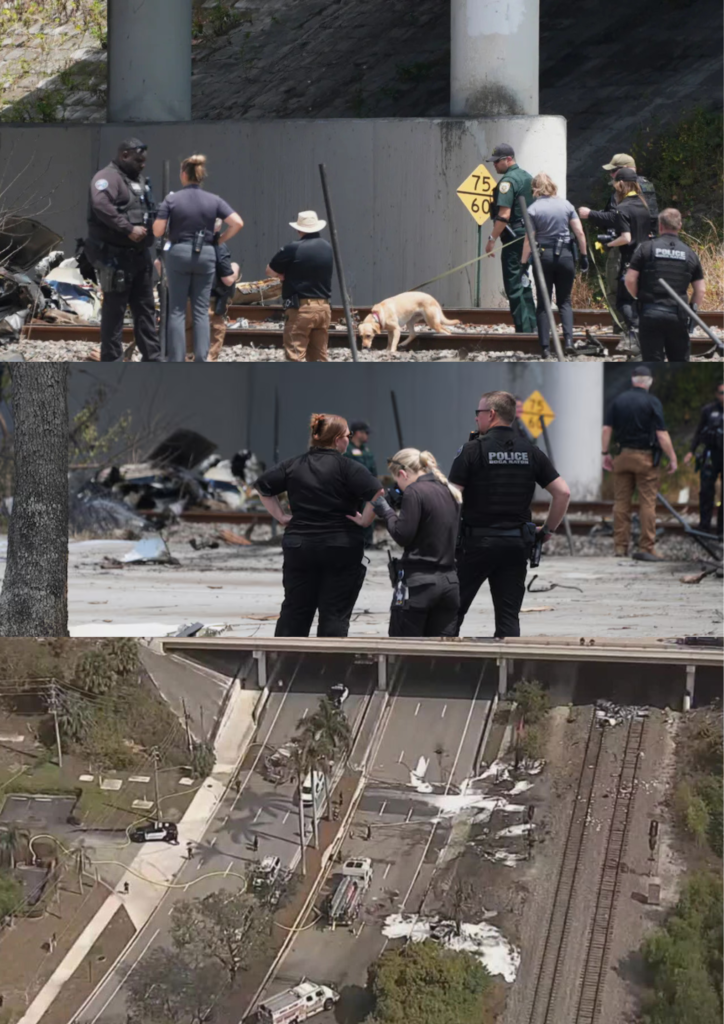Subhead: A fiery crash claims three lives near a bustling Florida highway, igniting debates over aviation safety and airport oversight.
BOCA RATON, Fla. (TDU) — A quiet Friday morning in Boca Raton was shattered when a twin-engine Cessna 310 plummeted onto Military Trail, erupting into a fireball that killed all three passengers and left a community grappling with shock and grief. The crash, which occurred just minutes after take off from Boca Raton Airport, has sparked heated discussions online, with social media users raising pointed questions about mechanical failures, pilot error, and the safety of small aircraft operating near busy urban areas.
A Devastating Scene Unfolds
At approximately 10:20 a.m. on April 11, 2025, emergency crews rushed to the 1900 block of Military Trail, where the wreckage of the Cessna lay strewn across railroad tracks, flames consuming what remained. Witnesses described a harrowing spectacle: a low-flying plane looping erratically before dropping below the treeline, followed by a deafening explosion that shook nearby buildings. “I heard it zooming by a couple of times, and then—boom,” one onlooker recounted, their voice trembling. “The whole building shook.”
The victims, identified by Boca Raton police as Robert Stark, 81, of Boca Raton; Stephen Stark, 54, of Delray Beach; and Brooke Stark, 17, also of Delray Beach, were pronounced dead at the scene. A driver, 24-year-old Pablo Tafur, narrowly escaped with non-life-threatening injuries after his Toyota crashed into a tree while navigating the fiery debris. “I’m lucky to be here,” Tafur told local media, describing how he swerved through flames to safety.
Mechanical Issues or Human Error?
Preliminary reports suggest the Cessna 310, built in 1977, experienced mechanical issues shortly after departing for Tallahassee International Airport. Air traffic control received distress calls from the pilot, who reported trouble maintaining control. Flight tracking data from FlightRadar24 shows the plane circling the airport multiple times, its altitude dangerously low, before the fatal plunge.
But on X, the narrative is far from settled. Posts circulating on the platform question whether the airport denied the plane emergency landing clearance—a claim that remains unverified but has fueled speculation. “If they were begging to land and got turned away, heads need to roll,” one user wrote, garnering thousands of retweets. Others point to the plane’s age, with some calling for stricter regulations on older aircraft. “A 50-year-old plane flying over a packed city? Recipe for disaster,” another post read.
The National Transportation Safety Board (NTSB) has launched a full investigation, with a preliminary report expected within 30 days. “We’re looking at everything—pilot qualifications, maintenance records, and environmental factors,” NTSB spokesperson Kurt Gibson said during a Friday briefing. Yet, for many, the wait for answers feels agonizingly slow.

A Community in Mourning—and Anger
Boca Raton Mayor Scott Singer expressed condolences, calling the crash a “heart breaking loss for our community.” But online, grief is intertwined with frustration. X users have flooded the platform with hashtags like #BocaCrash and #AviationSafety, demanding accountability. Some posts criticize the proximity of Boca Raton Airport to densely populated areas, arguing that small planes pose an unacceptable risk. “Why are we allowing these death traps to fly over schools and highways?” one viral post asked, referencing the crash’s location near Florida Atlantic University and Boca Raton High School.
Aviation experts, however, caution against jumping to conclusions. Robert Katz, a veteran pilot and instructor, noted that 70-80% of civilian crashes stem from pilot error when weather isn’t a factor. “The investigation will dig into the pilot’s training, the plane’s maintenance history, and even the airport’s protocols,” Katz told CNN. Still, the public’s impatience is palpable, with some X users speculating about systemic failures in oversight. “FAA needs to step up before more families are torn apart,” read one widely shared post.
A Survivor’s Tale and a City on Edge
Pablo Tafur’s survival story has captivated local attention. The young driver described a split-second decision to brake and swerve as flames engulfed the road ahead. “I thought I was done for,” he said, visibly shaken. His escape, while miraculous, underscores the crash’s ripple effect: Military Trail remains closed, railways are disrupted, and commuters are navigating detours as investigators comb the scene.
For Boca Raton’s aviation community, the crash is a gut punch. Todd Smith, a flight instructor at Lynn University, witnessed the plane’s erratic path from the ground. “It’s devastating,” he told reporters. “You train for emergencies, but seeing it happen so close—it shakes you.” Yet, some students, like 19-year-old Jared Scarpato, remain undeterred. “I’d get in a plane an hour from now,” Scarpato said defiantly, echoing a resilience that contrasts with the community’s unease.
What’s Next?
As the NTSB pieces together the puzzle, Boca Raton faces tough questions about its airport’s role in a growing city. On X, the crash has become a lightning rod for broader debates about aviation safety, with users sharing videos of the wreckage and eyewitness accounts that amplify the tragedy’s visceral impact. One post, showing plumes of black smoke rising above Military Trail, has been viewed over a million times, captioned simply: “This can’t keep happening.”
For now, the focus remains on the Stark family and the lives cut short. Memorials are already springing up online, with tributes praising Brooke Stark’s bright future and the family’s deep ties to the area. But as Boca Raton mourns, the call for answers grows louder—on X and beyond.
“We’re a strong community, but this hurts,” Mayor Singer said. “We need to know why this happened, and we need to make sure it never happens again.”
